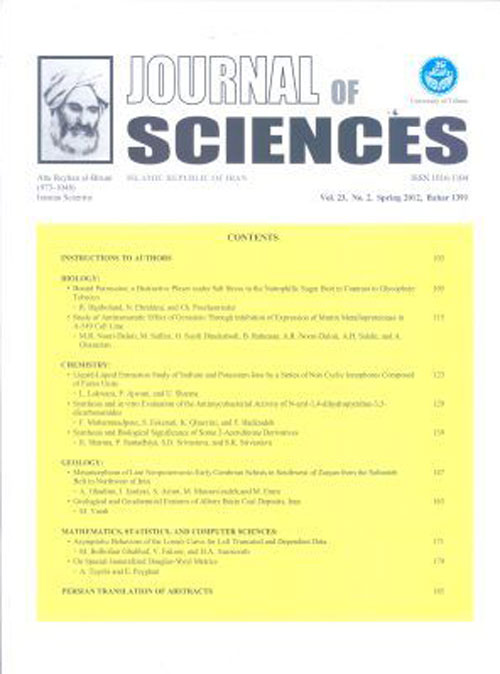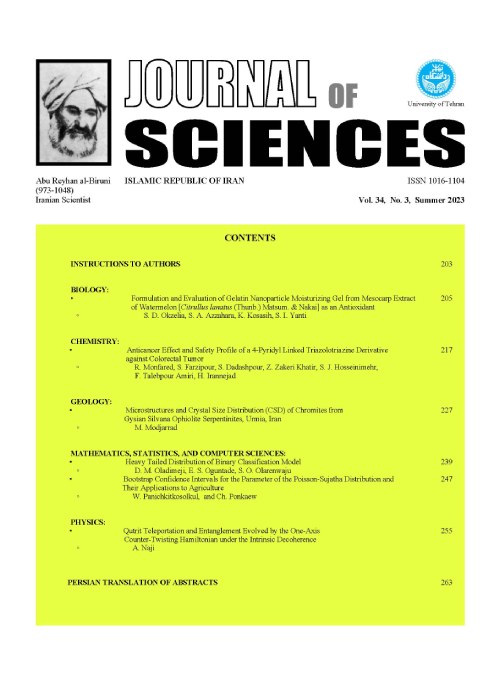فهرست مطالب

Journal of Sciences, Islamic Republic of Iran
Volume:33 Issue: 1, Winter 2022
- تاریخ انتشار: 1401/01/31
- تعداد عناوین: 6
-
-
Pages 5-18
Glucose oxidase (e.C1.1.3.4) is a flavoenzyme that catalyzes the oxidation of β-D-glucose to D-gluconolactone and hydrogen peroxide. The D-gluconolactone hydrolyzed spontaneously produces gluconic acid. Glucose oxidase has been widely used in chemical, food industries, and medicine. In this study, the glucose oxidase gene was identified in the chromosomal DNA of Aspergillus niger and isolated by PCR techniques. The glucose oxidase gene was then synthetically designed, optimized, cloned, and transferred into suitable hosts. The constructed clones were selected to modify the best production and combined promoter systems to produce glucose oxidase enzymes. In this design, the PCR product fragment was cloned into pPIC9 plasmids and transferred into Pichia pastoris GS115 by electroporation. The constructed strain was named pp.pPIC9/GOX. This strain was selected as a host for the other synthetic construct called pGAPZ/GOX. The strain pp.pPIC9/GOX was transformed as the host for the pGAPZ/GOX construct containing the glucose oxidase gene, which is controlled by the pGAPZa promoter with a self-inducing promoter and the newly constructed strain named pp.pPGAPZ/PIC9/GOX. The expression and comparison of the glucose oxidase activity were investigated by combining methanol and self-induction promoter in both pp.pPIC9/GOX and pp.pPGAPZ/PIC9/GOX strains simultaneously, which led to higher glucose oxidase gene activity in the new strain. Using the methanol induction promoter with the simultaneous expression of self-induction promoter in separate constructs and same strains increased the glucose oxidase gene activity.
Keywords: Glucose Oxidase, Pichia Pastoris GS115, Recombinant Combination Strategy -
Pages 19-26
To measure the concentration of Ag+ cation in solutions, a new optical chemical sensor was fabricated by covalent immobilization of Thiazole yellow dye on a triacetyl cellulose film via a linker, called epichlorohydrin. The interaction between the Ag+ cation and immobilized Thiazol yellow molecules was investigated using UV-Vis spectrophotometry. The fabricated optode indicated a range from 3×10 -7 to 2.5×10-5 M regarding to the concentration of Ag+ cation at pH 6 and the detection limit was searched to be: 0.8×10-7 M. The constructed optical chemical sensor, shows a long-term stability, good reproducibility and repeatability,and also satisfied selectivity and sensitivity. The sensor response to Ag+ cation is absolutely invertible and it can be reproduced simply with a solution of EDTA (ethylenediamine tetra acetic acid) in about 5 minutes. The response time is 10 minutes. The fabricated optode can be employed successfully to determine the concentration of Ag+ cation in actual sample solutions.
Keywords: Epicholorohydrin, optode, Silver (I) ion, Thiazole yellow, Triacetyl cellulose, Covalent immobilization -
Pages 27-44The study area is located in Tang-e Bagh at Kuh-e Genu, approximately 69 km, northern Persian Gulf. The age relationships of Sarvak, Gurpi, and Pabdeh formations were unclear in the study area because of the low-resolution biostratigraphy. Therefore, 152 samples were collected. All samples contain well-preserved foraminifers that permit clarification of the age of these formations. Nine benthic species (5 genera) and sixty-eight planktonic foraminiferal species (29 genera) were identified that were arranged eleven biozones with high resolution of biostratigraphy. Biozone Ⅰ corresponds to the total range of Orbitolina qatarica in the Mauddud Member of Sarvak Formation, suggesting the Cenomanian (middle Cenomanian) age. The biozone Ⅱ is characterized by the total range of Dicarinella asymetrica in the basal part of Gurpi Formation, indicating the Santonian age. Therefore, there is a hiatus between the Sarvak and Gurpi formations that includes part of the Mauddud Member, the whole Ahmadi Member, and the Ilam Formation. This hiatus encompasses the late Cenomanian to Coniacian that is marked by a few meters of Fe-stained deposits in the Kuh-e Genu; the interval range zones Ⅲ to Ⅶ as well as Abathomphalus mayaroensis zone Ⅷ (TRZ) are present within the rest of Gurpi Formation and suggests the Campanian to Maastrichtian. The biozones IX-XI are present within the Pabdeh Formation that corresponds to a Not Zone and two interval range zones (P1b, P1c-P2), suggesting Danian. Based on microfacies, texture, and paleontological analysis, a deep-water environment suggests for Gurpi and Pabdeh formations and shallow marine conditions for Sarvak Formation.Keywords: Biostratigraphy, Upper Cretaceous, Lower Paleogene, Kuh-e Genu, NW Persian Gulf
-
Pages 45-54In this article, we propose the gamma kernel estimator for the cumulative distribution functions with nonnegative support. We derive the asymptotic bias and variance of the proposed estimator in both boundary and interior regions and show that it is free of boundary bias. We also obtain the optimal smoothing parameter which minimizes the mean integrated square error (MISE). In addition to consistency, we prove the almost sure convergence of the proposed estimator and show that it follows the same approximate normal distribution as empirical distribution. We presented a simulation study to compare the performance of the proposed estimator with other estimators. We use the proposed estimator to estimate the cumulative probability distribution function of the food expenses for urban households in Iran.Keywords: Asymmetric kernels, cumulative distribution, boundary problem, almost sure convergence
-
Pages 55-63Real count data time series often show the phenomenon of the overdispersion. In this paper, we introduce the first-order integer-valued autoregressive process. The univariate marginal distribution is derived from the Delaporte distribution and the innovations are convolution of Poisson with -fold zero modified geometric distribution, based on binomial thinning operator, for modelling integer-valued time series with overdispersion. Some properties of the model are derived. The methods of Yule–Walker, conditional lea st squares and conditional maximum likelihood are used for estimating of the parameters, and their asymptotic properties are established. The Monte Carlo experiment is conducted to evaluate the performances of these estimators in finite samples. The model is fitted to time series of the weekly number of syphilis cases that are overdispersed count data.Keywords: : α-fold zero modified geometric, Binomial thinning, Count time series, Delaporte distribution, INAR (1) models
-
Pages 65-70The surface waves propagating in a cylindrical thin plasma layer are studied. The cylindrical plasma layer is sandwiched between two regions of different dielectric constants. The linear dispersion relation is obtained by starting from the fluid model and Maxwell’s equations. It is found that a hybridization occurred between the plasmonic oscillations and the acoustic excitation, which leads to a new surface mode in the present plasma system. Furthermore, it can be seen that the wave frequency is significantly tunable due to the optimization of the plasma parameters and the cylindrical geometry. Surface mode frequency can increase by increasing Fermi speed at low frequencies and approaching the light speed line. Using the present plasma layer model not only leads to a new coupling between the plasmonic oscillations and the acoustic excitation, but also provides a new mode that is more controllable due to the additional parameters of the model. The present results should be applicable for understanding the basic characteristics of plasma antenna, enantiomeric sensing devices and plasma-sensing based waveguides.Keywords: surface waves, Plasma Layer, Plasmon-polariton


